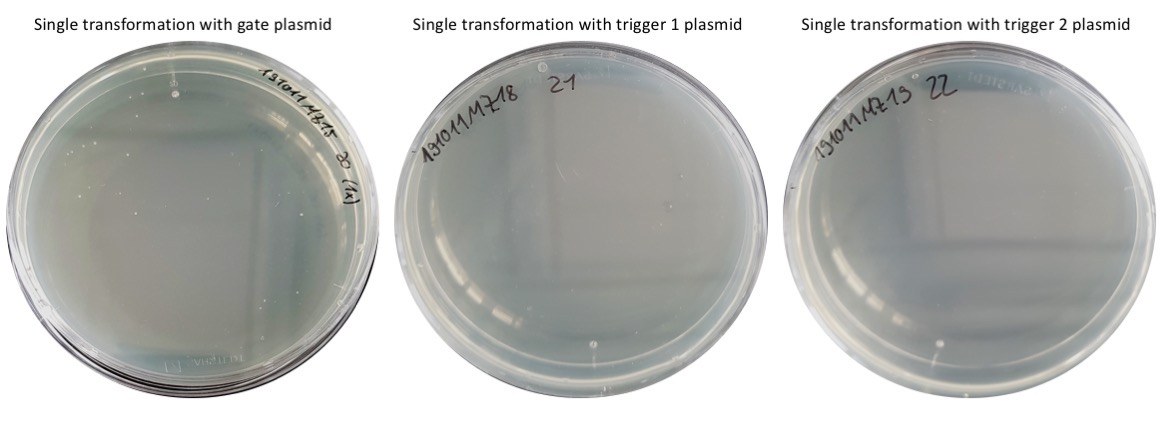Difference between revisions of "Part:BBa K2970003"
| Line 24: | Line 24: | ||
After transformation of both trigger plasmids (<partinfo>BBa_K2970003</partinfo> and <partinfo>BBa_K2970004</partinfo>) and the gate plasmid (<partinfo>BBa_K2970006</partinfo>) in one bacterium all three mRNA structures will be formed, the gate will be opened, and the translation of the chloramphenicol resistance can take place. Bacteria that took all three plasmids are able to survive on media with chloramphenicol. This system can be used to transform many genes of interest on three different plasmids into bacteria with only using one antibiotic resistance instead of three different resistances. | After transformation of both trigger plasmids (<partinfo>BBa_K2970003</partinfo> and <partinfo>BBa_K2970004</partinfo>) and the gate plasmid (<partinfo>BBa_K2970006</partinfo>) in one bacterium all three mRNA structures will be formed, the gate will be opened, and the translation of the chloramphenicol resistance can take place. Bacteria that took all three plasmids are able to survive on media with chloramphenicol. This system can be used to transform many genes of interest on three different plasmids into bacteria with only using one antibiotic resistance instead of three different resistances. | ||
| − | |||
| − | |||
===Usage and Biology=== | ===Usage and Biology=== | ||
| + | This part can be used together with the other trigger composition and the gate composition for triple transformation in bacteria. Genes of interest that should be transformed together, can be put on the three plasmids. Only if all three plasmids are taken by a bacterium the chloramphenicol resistance is produced and the bacterium can survive on medium with chloramphenicol. Thus chloramphenicol can be used to select for bacteria that got all genes of interest. | ||
| + | |||
| + | ===Results=== | ||
| + | We tested this part by performing triple transformations of this part in pSB1A3 together with the other trigger composition and the gate composition, in pSB1A3 backbones as well. After transformation we selected by plating the bacteria on plates with chloramphenicol. We compared the results with positive and negative controls. Furthermore we did single transformation of each part. | ||
| + | We had colonies on plates with bacteria transformed with both trigger plasmids and the gate plasmid. | ||
| + | |||
| + | <html> | ||
| + | <figure> | ||
| + | <img src="https://2019.igem.org/wiki/images/e/ec/T--Hamburg--ResultsFigure4.jpeg"> | ||
| + | <figcaption> | ||
| + | <b>Figure 1: </b>Cell plated out on chloramphenicol agar plates. Left: Cells transformed with gate composition. Middle: Cells transformed with trigger 1 composition. Right: Cells transformed with trigger 2 composition. | ||
| + | </figcaption> | ||
| + | </figure> | ||
| + | </html> | ||
| + | |||
| + | Due to leaking of the gate colonies could be found on plates were bacteria were transformed with the gate composition. In contrast, the single transformations with the trigger compositions were negative, as expected. | ||
| + | |||
<!-- --> | <!-- --> | ||
Revision as of 10:13, 21 October 2019
Trigger 1 Composition
Trigger 1 forms together with Trigger 2 (BBa_K2970001) a complex due to complementary regions, as shown in Figure 1. This complex can open a gate (BBa_K2970002, Figure 1B) to enable translation of a gene that is locked with this gate to regulate translation. After binding of the trigger complex due to complementarity, the hairpin of the gate will open and release the ribosome binding site and the start codon, thus translation can occur (Figure 2). The affinity between the trigger complex and the gate is greater than that of the gate to itself (in the loop). A single trigger cannot open the gate because it has only half the required complementary sequence.


Usage and Biology
This part can be used together with the other trigger composition and the gate composition for triple transformation in bacteria. Genes of interest that should be transformed together, can be put on the three plasmids. Only if all three plasmids are taken by a bacterium the chloramphenicol resistance is produced and the bacterium can survive on medium with chloramphenicol. Thus chloramphenicol can be used to select for bacteria that got all genes of interest.
Results
We tested this part by performing triple transformations of this part in pSB1A3 together with the other trigger composition and the gate composition, in pSB1A3 backbones as well. After transformation we selected by plating the bacteria on plates with chloramphenicol. We compared the results with positive and negative controls. Furthermore we did single transformation of each part. We had colonies on plates with bacteria transformed with both trigger plasmids and the gate plasmid.

Due to leaking of the gate colonies could be found on plates were bacteria were transformed with the gate composition. In contrast, the single transformations with the trigger compositions were negative, as expected.
Sequence and Features
- 10COMPATIBLE WITH RFC[10]
- 12INCOMPATIBLE WITH RFC[12]Illegal NheI site found at 7
Illegal NheI site found at 30 - 21COMPATIBLE WITH RFC[21]
- 23COMPATIBLE WITH RFC[23]
- 25COMPATIBLE WITH RFC[25]
- 1000COMPATIBLE WITH RFC[1000]
